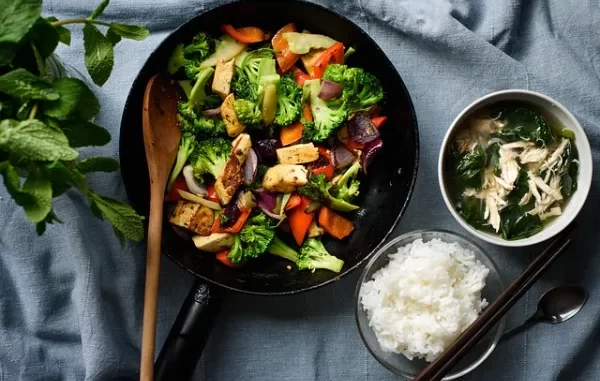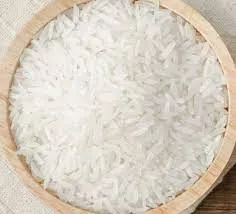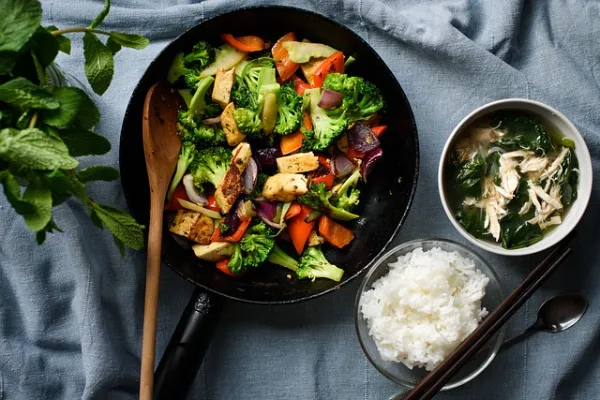
Rice is one of the most popular and widely consumed grains in the world. It’s healthy, delicious, and can be used in a variety of dishes. But did you know that there are some fun facts about rice that you may not know? From the origin of its name to its role in various cultures, here are some fun facts about rice that you may find surprising.
“Rice as a Dietary Staple: How it Became a Global Phenomenon”
Rice has been a dietary staple for much of the world for centuries, and its importance as a food source has become increasingly prominent in recent decades. From its initial cultivation in its native Asia to its current widespread production and consumption across the globe, rice has become a true global phenomenon.
Rice was first cultivated in China as early as 5000 BC, and it quickly spread to other parts of Asia, including India, Japan, and the Middle East. Over time, it became an essential part of the diet in many of these regions, providing a reliable source of energy and nutrition. By the 16th century, rice had spread to the Americas, and it was soon being cultivated in many of the colonies of the New World.
Throughout the 19th and 20th centuries, rice production steadily increased, and it came to be recognized as an important food source for both developing and developed countries. Its popularity was driven in part by its easy cultivation and low cost compared to other grains, and it soon became a dietary staple in many parts of the world.
Today, rice is grown on every continent except Antarctica, and it is estimated that nearly half of the world’s population consumes it regularly. It is a key component of many cuisines and diets, and it is a major source of nutrition for millions of people. It is also a major source of income for farmers in many regions, as it is one of the most widely traded commodities in the world.
The global popularity of rice is undeniable, and it is likely to remain a dietary staple for many years to come. Its versatility, reliability, and affordability make it an essential part of the diets of people around the world. Its continued success is testament to its enduring importance in global food culture.
“Rice, Rice Everywhere: The Diverse Varieties of Rice”

Rice is one of the oldest and most widely consumed staples in the world. It is an important part of diets in many countries, and is especially important in Asian cuisine. There are hundreds of varieties of rice, each with their own unique characteristics and uses.
Long grain rice is one of the most common varieties, and is easily recognizable due to its long, slender shape. It is perfect for dishes with a lot of liquid, such as risotto, as it is able to absorb a lot of liquid without becoming mushy. It can be used to make a variety of dishes, from fried rice to paella.
Short grain rice is another common type, and is characterized by its small, round shape. It is most commonly used for sushi, as it is sticky when cooked and helps the sushi to hold together. It is also often used in dishes like risotto and paella, as it is able to absorb a lot of flavor.
Medium grain rice is a bit more versatile than the other two varieties, as it is able to hold its shape better than long grain, but still absorbs liquid and flavor like short grain. It is often used in dishes like rice pudding, as it absorbs the liquid and flavor while still keeping its shape.
Forbidden black rice is one of the most unique varieties of rice. It is so-named because it was once reserved for Chinese royalty and forbidden to commoners. It is high in antioxidants, and has a deep purple color when cooked. It can be used as a substitute for long grain or short grain in many dishes.
Finally, jasmine rice is a fragrant, long grain variety that has a sweet, nutty flavor. It is commonly used in Southeast Asian dishes, such as Thai curries, and is one of the most popular varieties of rice. It is often served alongside fish or vegetables to provide a delightful contrast to the other flavors.
Rice is a versatile and delicious staple that can be used in a variety of dishes. From long grain to forbidden black, there is something for everyone. No matter what variety you choose, you can be sure that your meal will be flavorful and satisfying.
“Rice Around the World: How it Influences Different Cultures”
Rice is one of the most widely consumed food staples around the world, providing sustenance to over half of the global population. It is a dietary mainstay in many countries, and its versatility means it can take on many different forms and flavors. But its impact goes far beyond the dinner table. Rice has had a profound influence on the culture, history, and economy of many nations across the globe.
Rice has been an integral component of Asian cuisine for centuries, and it is a staple in many countries, including India, China, Japan, Indonesia, and Thailand. In many of these countries, the harvesting and cultivation of rice is a deeply entrenched tradition, and it has played a critical role in the development of their societies. In China, for example, rice farming has been an essential part of the country’s economy for centuries, and it is still a key industry today. Rice is also an essential ingredient in many traditional dishes, such as sushi in Japan and biryani in India.
In Southeast Asia, rice plays a particularly important role in the economy and society, as it is a major source of food security in the region. Rice is also a major part of the cultural identity in these countries, with traditional festivals and ceremonies often revolving around the harvesting of the crop.
In Africa, rice is mostly cultivated along the continent’s major rivers, including the Niger and Congo. In West Africa, rice is sometimes referred to as “the mother of all grains,” and it is an essential part of the economy and culture of many countries. In Ghana, for example, it is a staple in many traditional dishes, such as jollof rice and banku.
Rice has also had an influence on the culture and economy of the Americas. In the Caribbean, for example, rice is an important part of many traditional dishes, such as the Jamaican national dish, ackee and saltfish. In the United States, rice is a major crop in the south, and it has been an important part of the country’s history and identity.
It is clear that rice has had a profound influence on the cultures and economies of many different countries around the world. Its versatility and nutritional value has ensured that it remains a staple in many diets, and its importance to many cultures cannot be overstated.
“From the Kitchen to the Lab: Innovative Cooking and Scientific Uses for Rice”

Rice is an ancient grain that is still widely consumed today and is a staple food in many cultures. Its versatility, nutrition, and affordability have made it a popular choice for cooks and scientists alike. From the kitchen to the lab, rice is being used in innovative ways to create delicious dishes and groundbreaking scientific discoveries.
In the kitchen, rice can be cooked in a variety of ways to create delicious meals. It can be boiled, steamed, fried, or roasted. Rice can also be used to make risotto, sushi, and other savory dishes. Rice can be cooked with different seasonings and herbs to add flavor, making it a customizable ingredient. Additionally, rice is a valuable source of nutrition, providing essential vitamins and minerals such as iron, magnesium, and thiamine.
In the lab, rice is being used to make scientific breakthroughs. Scientists are using rice to develop new medicines, treatments, and other health-related products. Rice is also being used to create biofuels and to develop new sustainable energy sources. Additionally, researchers are exploring the use of rice as a source of food for livestock and fish.
Rice is a versatile ingredient that is being used in many different ways. From the kitchen to the lab, rice is playing an important role in innovative cooking and scientific advancements. Whether it is used in the kitchen or in the lab, rice is a valuable asset for both cooks and scientists.
“Rice: A Historical Perspective on the Evolution of a Food”
Rice has been an important staple of the human diet for thousands of years, with evidence of its cultivation dating back to ancient China, India, and Southeast Asia. The grain has since spread throughout the world, becoming a dietary staple in many cultures. In this article, we will explore the history of rice and its evolution as a food, from its origins in the ancient world to its current prominence in modern cuisine.
Origins
Rice is thought to have originated in the Yangtze River valley of China more than 8,000 years ago. The grain was domesticated by the Chinese and spread throughout Asia, reaching India, the Middle East, and other parts of the world by the 4th century BCE. In India, rice was widely cultivated and consumed, with some varieties being used in religious ceremonies.
Spread
Rice had spread to other parts of the world by the time of the Roman Empire. In the Mediterranean, rice was used for both culinary and medicinal purposes, and it was also grown in the fields of North Africa. By the Middle Ages, rice was being cultivated in Europe, with Italy becoming a major producer.
In the Americas, rice reached the Caribbean islands in the 16th century and was cultivated by the Spanish and Portuguese. It spread to North America in the 17th century, when it was planted in the Carolina colonies. Today, the United States is one of the largest producers of rice in the world.
Modern Times
Rice has become a major staple of the modern diet. It is a key ingredient in many dishes from around the world, and is also consumed as a side dish or as a snack food. Rice has become a popular staple in many cultures, with some countries relying heavily on it for food security.
Rice has also been used in a variety of industrial and technological applications. The grain is used to make paper, fuel ethanol, and even bioplastics. It is also used in the production of cosmetics, pharmaceuticals, and even textiles.
Rice Facts Conclusion
Rice is a food that has been part of the human diet for thousands of years. Its spread throughout the world and its versatility in cuisine and industrial applications have made it an indispensable part of the modern diet. As we continue to explore the history and evolution of this important grain, it is clear that its importance in the world is likely to remain for many years to come.
Rice is an incredibly versatile and nutritious food that has been a staple in many different cultures around the world for thousands of years. It is a staple in many diets and is one of the most widely consumed grains in the world. Rice is a great source of vitamins, minerals, and other essential nutrients, making it an important part of any healthy diet. Fun facts about rice show how incredible and versatile this food can be, and how it has been a source of nutrition for so many over the years.
If you liked our article Fun facts about rice, you might also like Fun facts about popcorn.






Leave a Reply